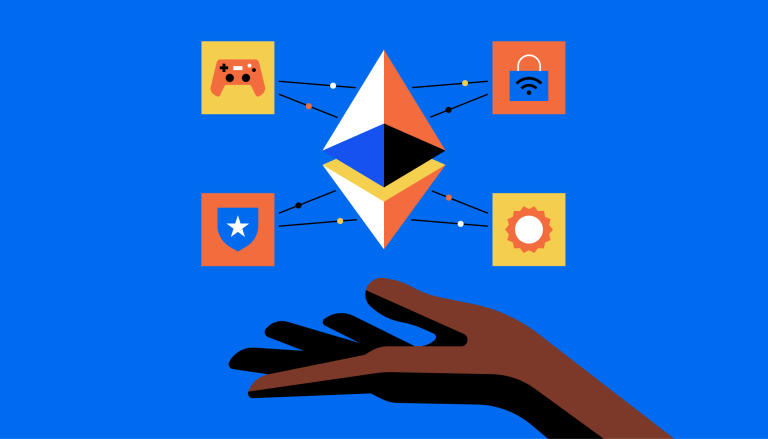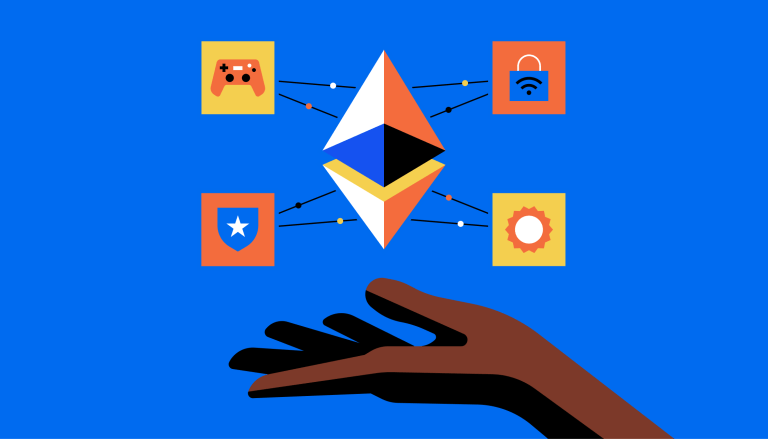A Complete and Simple Guide to the Top NFT Blockchains
When it comes to NFTs, the Ethereum blockchain is king. Considered by many to be the one-stop shop for NFTs, over the past year it has quickly become the most talked about – and at times the most trafficked – blockchain in existence.
Yet, numerous other blockchains have been becoming increasingly popular within the NFT space. Considering the high transaction costs and environmental impact that the Ethereum blockchain presents, crypto-artists and NFT enthusiasts have continued to seek out new places to mint and trade NFTs.
But there are several things to consider when choosing what blockchain to mint on. Some of the most important points are network size, creator costs, consumer spending habits, security, and community input. So to provide a bit of clarity to the widespread and fast-paced world of web3 tech, we’ve created a high-level summary of blockchains for NFTs.

Which blockchains support NFTs
Ethereum
The most popular blockchain for NFTs is currently Ethereum. It’s highly decentralized and provides all the financial and legal services one typically needs for transactions without the need for any intermediaries. It also houses some of the most popular NFT marketplaces (OpenSea), NFT projects (CryptoPunks and the Bored Ape Yacht Club), and NFT artists (Pak and Beeple).
Unfortunately, it is also one of the most expensive options and uses a lot of energy. This is because Ethereum works using a Proof-of-Work (PoW) mechanism. In short, PoW requires computers to compete with one another to solve complex puzzles to add blocks and transactions to the blockchain. These puzzles are remarkably complex and require a lot of computer power to solve, resulting in astronomical amounts of energy loss.
However, thanks to its popularity, security, decentralization, and ease of use, you should consider this blockchain first when deciding where to mint.
Solana
Solana is one of the fastest programmable blockchains in the crypto space. Its unique combination of proof-of-history (PoH) and proof-of-stake (PoS) consensus mechanisms remove the need for such complex puzzles. This results in substantially reduced validation times and fees.
With PoS, users stake an amount of their cryptocurrency for the chance to be randomly chosen as a block validator. Validators earn SOL when they are selected. This serves to both incentivize users to become stakers and reward them for becoming stakers. PoH works in tandem with PoS and is used to cryptographically verify the passage of time between two events. In terms of the Solana blockchain, it’s used to ensure that transactions are in the right order and found by the correct leader (validator).
In truth, thanks to Solana’s PoS and PoH mechanisms, its transaction fees and times are about as low as they can get. However, Solana isn’t as widely used as Ethereum, meaning there are both fewer NFT marketplaces and fewer people trading on the blockchain.
Tezos
For a greener alternative, consider the Tezos blockchain. Tezos rose to popularity towards the beginning of 2021. One of the first marketplaces on the blockchain, Hic et Nunc, was heralded as being an economic alternative to Ethereum-centric marketplaces till the platform shut down on Nov. 14, 2021.
Similar to Solana, Tezos uses a PoS consensus mechanism and only a PoS mechanism to help reduce the computational work needed to verify blocks and transactions on the blockchain. Because of this, the blockchain uses about two million times less energy than Ethereum. Additionally, it has lower fees than Ethereum (but does cost more than Solana).
Tezos is a great place to start for those looking to mint batches of NFTs or large-scale collections. Currently, Objkt is the largest and most popular marketplace on the Tezos chain.
Flow
Flow is a high-performance blockchain geared specifically towards creating NFTs, games, and decentralized apps (dApps). In stark contrast to general-purpose blockchains like Ethereum, Flow is built with scalability in mind, meaning billions of people could potentially interact with NFTs on the blockchain.
Originally launched in 2019, Flow quickly rose to prominence as the blockchain partner of the NBA. A product of Dapper labs (the team behind legacy project CryptoKitties), Flow facilitated the launch and is the host of NBA Top Shot, making the blockchain an integral component in the popularization of non-fungible tokens.
Similar to Tezos, Flow also uses a solely PoS consensus mechanism to verify transactions. Because of this, the blockchain can handle an exorbitant amount of transactions, with developers currently working towards a model to handle around 10,000 transactions per second. Transaction fees are also significantly low.
Aside from Blocktobay (a popular Flow-native NFT marketplace), Flow NFTs are tradeable via OpenSea, Rarible, Foundation, and many other platforms. Flow has become a popular place for sporting NFTs, as organizations like the NBA, NFL, UFC, and more have launched their own marketplaces on the blockchain. Yet, similar to Solana, Flow isn’t as widely used as Ethereum, resulting in fewer NFT marketplaces and fewer people trading on the blockchain.
Worldwide Asset Exchange (WAX)
WAX is considered king when it comes to digital collectibles and virtual items. Of course, this encompasses NFTs, but in contrast to Ethereum (where digital art and avatar projects run the market), WAX is popular for digitalized versions of legacy collectibles like trading cards, figurines, memorabilia, etc.
Similar to other high-efficiency blockchains, Wax employs a PoS mechanism, but also creates carbon offset NFTs, and partners with Climate Care as part of a mission for sustainability. Similar to Flow, transaction fees are significantly low, and as a unique incentive to collectors, network fees on WAX are redistributed to the WAX community.
WAX marketplaces also play host to a wide variety of influential brands including baseball collectibles company Topps, racing giant NASCAR, toy company Hot Wheels and even a few cult classic film franchises like Godzilla, The Princess Bride, and Spiderman.
Binance Smart Chain (BSC)
If you’re looking for a sweet spot between fees and performance, BSC is another good option. The problem is that the high-speed transactions and the low fees come at the cost of decentralization. BSC is the most centralized of the options listed here.
Binance Smart Chain uses a consensus model called Proof of Staked Authority (PoSA) which can support a short block time and low fees. Yet, the validators running transactions take turns to produce blocks — with the 21 validators needed to run the exchange switching out every 24 hours. According to some reports, 11 validators of the 21 control the Binance Chain and are all directly connected to the Binance Crypto Exchange.
While centralization is a turn-off to many within the crypto and NFT ecosystem, the BSC NFT market did begin to pick up some speed towards the end of 2021. Although the ecosystem is undoubtedly not even close to being as robust as that of Ethereum, marketplaces like OpenBiSea, AirNFTs, JuggerWorld, and more are gaining popularity.
The post A Complete and Simple Guide to the Top NFT Blockchains appeared first on nft now.

